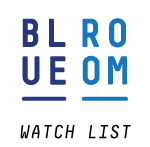Weekend Update #85
Welcome to Blue Room's Weekend Update. Each week, we're sharing what companies we're researching and the what, the who and the how that we think makes the companies interesting and unique. This roundup is brought to you weekly by a group of interns, creative minds, artists and investors who believe that through best in class investing along with the democratization of financial education we can do great things together. Enjoy, Explore and Share.Market performance this week was the icing on the cake for bullish investors. This week was jam-packed with events with a slew of earnings reports from some of the biggest names in the American indices, an FOMC rate meeting. The S&P 500 index finished +4.26%, the Nasdaq Composite capped the week up +4.70% and the Dow Jones Industrial Average gained +2.97%.
On the earnings end of the week, Coca Cola and McDonalds reported revenue above market expectations, both reporting that price increases were well tolerated by consumers. Coke said that both higher pricing and increasing global volume increased revenue 12.0% y/y. McDonald’s reported net sales of $5.72 billion, or -3.0% y/y, most notably slowed by store closures in Russia and Ukraine. In tech, Google parent, Alphabet, Microsoft, and Meta Platforms reported mixed results mid-week. For Google, the cloud services revenue fell short of expectations contributing to a year-on-year growth rate of 13%, down from 62% in the same period last year. Microsoft reported Azure and other cloud services growth of 40% although missed slightly on revenue and earnings estimates. Like many other Ad based platforms, Microsoft reported that YouTube was facing a decrease in advertising interest and increased competition from TikTok as headwinds. Meta Platforms also fought an upstream battle this quarter against the advertising momentum. The company missed against market estimates on both the top and bottom lines, and indicated that a, “continuation of weak advertising demand environment” in the second quarter caused their profit woes. Many advertisers are tapering budgets as the macroeconomic outlook for consumer demand appeared weaker over the past three months. All of the major tech companies operating globally reported foreign exchange rate headwinds caused by a strong relative dollar.
Turning to policy and economics, the Federal Reserve held a FOMC press meeting on Wednesday where Fed Chair Jerome Powell announced a 75 bps rate hike, the second consecutive hike of that magnitude. That brings the current Federal Funds Target Rate to ~2.25%, with the terminal rate for the end of this year hovering around 3.50% to 3.75%. During the presentation, Powell indicated that the labor market continues to show resilience in the face of higher inflation which proves a way for continued rate increases. He also communicated that the U.S. economy was not in a recession, even despite the first 2Q GDP reading showing that the country output 0.9% less on an annualized basis.
MAJOR INDICES - PERFORMANCE THIS WEEK
S&P 500 - Finished up, +4.26%
Nasdaq - Finished down, +4.70%
DJIA - Finished down, +2.97%
Thank you Blue Room Analyst IAN CARTER
This was a busy week full of earnings and economic news, one of the largest pieces being the latest GDP number, which came in at -0.9% for the second quarter, which immediately spurred a debate around whether the U.S. is in a recession. The traditional definition of recession calls for two consecutive quarters of negative GDP growth. However, the White House, the NBER and other market participants and observers say there is a variety of other economic indicators that, in aggregate, help to better define recession, including real personal income less transfers, nonfarm payroll employment, industrial production, real wholesale and retail sales and real consumer spending. What is certain is that companies have begun implementing hiring freezes and job cuts, citing an uncertain macroeconomic environment as the rationale behind their short-term plans going forward.
INTC 2Q22 BLUE ROOM ANALYST NOTES
All measures came in below expectations operationally due to macroeconomic trends and poor execution on Intel. Weak macro was described by CGO David Zinser as being impacted by inflation, interest rates, and the Ukraine war. That led to OEMs lowering inventory purchases to hedge against broad based decline in demand. Both demand and cost headwinds arose from the shutdowns in China.
More specifically, CCG and DCAI forecasts are weaker going into Q3. The company sees CCG TAM decreasing 10% this year, the primary driver. Global TAM weakness coming from consumer, education and small to medium sized businesses end markets. Interest to note 11.0% y/y increase in ASPs based on product mix, indicating higher demand for better performance client chips.
In DCAI, Intel is working on overhauling its server product portfolio, which has allowed competition to eclipse them. In addition, OEM inventory reductions drag down the related ASPs for Intel against these competitors. With certain product rollouts coming soon, and design wins with Meta, Amazon and Nvidia, the company sees potential relief in growth pressure. It is important to note that the datacenter business seems to only be a weak spot for Intel, with other semiconductor companies that have reported already stating that DC is the strongest segment offsetting weakness in client.
IFS revenue was down due to lower mask tool sales and continued automotive segment shortage issues. Near-term financials are struggling due to macro, but continued capital investment may turn this around. MediaTek, a large customer of TSMC, agreed to a deal with IFS for contract manufacturing in the US. MediaTek is a large semiconductor design firm from Taiwan.
Capital allocation improvements: exiting 6 businesses since Pat Gelsinger appointment as CEO. Focusing on growth of core business opportunities like IFS, five chips in four years, and recapturing tech leadership in DCAI.
Zinsner articulated that he believes that Intel will reach a financial bottom in Q3. Overall the FY2023 outlook is clearly weaker; negative 1.5 billion dollars in adjusted FCF, 49.0% GM (below the target of 51.5%), and a -12.5% downward revision in revenue.
We are concerned that the rollout of Sapphire Rapids while the server CPU side is slowing will create inventory cost headwinds for the company in the latter half of this year.
The macroenvironment continues to be a major factor for advertisers and will continue to negatively impact Roku for the rest of the year as executives substantially lowered their guidance for Q3, as well as withdrawing full year guidance which was previously estimated to be 35% year-over-year growth.
Management explained the largest impact was in the ad scatter market (ads that are typically bought on demand — "short term"). Advertisers worried about a possible recession are cutting spend in places where it is easy to turn off and back on which is impacting Roku's short term revenue. Upfronts (ads bought in advance — "long term") appear to be doing well as Roku just surpassed $1 billion in commitments for next year which is a new milestone for the company.
The larger than expected beat on active accounts was only a "temporary blip," partially driven as a result of promotional activity from retailers to reduce inventory which increased sales on Roku TVs and devices.
The Q3 guide of $700 million in revenue implies a 3% year-over-year growth rate indicating the pullback in ad spending is more significant than originally forecasted. Roku indicated that it is still gaining share in the ad market which is a plus, and puts them in a better position when ad spend returns to normal. Executives believe the cutback in ad spend will force advertisers to accelerate the transition to streaming as linear TV continues to lose market share of household watch time. Additionally, average hours per account and total streaming hours also came in higher than expected which indicates higher engagement, a key metric for advertisers.
Roku is also planning to manage expenses for the rest of the year by reducing its expected Y/Y growth rate for operating expenses by 10% in Q3 and 25% in Q4 to bring OpEx back down to growth level comparable to Q1 (54%).
The final July reading of 51.5 showed little change in consumer sentiment from its historic low of 50.0 in June. The one-year economic outlook fell to its lowest reading since 2009.
At the same time, concerns over global factors have eased somewhat. This easing provided some limited support to buying conditions for durables, which remained near the all-time low reached last month, as well as a modest retreat in long-run inflation expectations.
However, inflation continued to dominate consumers’ attention, and labor market expectations continued to soften. This month’s consumer sentiment index reading was the second lowest on record, and the Q2 slowdown in personal consumption expenditures was no surprise
Amazon.com, Inc. is an online retailer that offers a wide range of products. The Company products include books, music, computers, electronics and numerous other products. Amazon offers personalized shopping services, Web-based credit card payment, and direct shipping to customers. Amazon also operates a cloud platform offering services globally.
After falling more than 40% in the month of June, U.S. natural gas futures soared to new highs this week, reaching prices not seen since July 2008. Natural gas is up more than 60% in the month of July, largely due to imbalances in supply and demand.
To understand the demand side of natural gas futures, it is necessary to understand who is consuming natural gas. In the United States, 37% of natural gas consumption comes from the electric power sector – amounting to 11.27 trillion cubic feet in 2021. The industrial and residential sectors consumed 33% and 15%, respectively, of U.S. natural gas. So, as the United States was enveloped by a heat wave forcing people to turn on their air conditioning, demand for natural gas greatly increased.
However, it is important to note that countries outside of the United States do account for a significant amount of natural gas demand. The United States has been steadily increasing its exports of natural gas to Europe. During the first four months of 2022, the United States exported 74% of its liquified natural gas to Europe. In April, it exported more than 8 million cubic feet per day of natural gas to Europe. This would account for roughly 10% of United States natural gas consumption if it were included into the pie chart pictured above.
Corporate Profile:
Our Mission: Give people the power to build community and bring the world closer together.
Our products empower more than 3 billion people around the world to share ideas, offer support and make a difference.
Our Culture: At Facebook, we are constantly iterating, solving problems and working together to connect people all over the world. That’s why it’s important that our workforce reflects the diversity of the people we serve. Hiring people with different backgrounds and points of view helps us make better decisions, build better products and create better experiences for everyone.
Our Principles: Our principles are what we stand for. They are beliefs we hold deeply and make tradeoffs to pursue.
Give People a Voice — People deserve to be heard and to have a voice — even when that means defending the rights of people we disagree with.
Build Connection and Community — Our services help people connect, and when they’re at their best, they bring people closer together.
Serve Everyone — We work to make technology accessible to everyone, and our business model is ads so our services can be free.
Keep People Safe and Protect Privacy — We have a responsibility to promote the best of what people can do together by keeping people safe and preventing harm.
Promote Economic Opportunity — Our tools level the playing field so businesses grow, create jobs, and strengthen the economy.
Highlights
Spotify outperformed on key metrics, including Monthly Active Users, Premium Subscribers and Revenue
Strength in MAUs was driven by successful marketing campaigns in Rest of World, reactivations in Europe and Gen Z strength in Latin America
Premium Subscriber growth was aided by promotional intake and household plans
As-reported Gross Margin of 24.6% was negatively impacted by a one-time Car Thing charge of €31 million; non-IFRS Gross Margin finished at 25.3%, slightly above guidance
Optimizing capital allocation for long-term value creation
Accelerating expansion into audiobooks with Findaway acquisition on June 15th
Pioneering creation of new user experiences with recently-announced acquisition of Sonantic, an AI voice platform
Reducing hiring growth for 2H 2022 by 25% and monitoring macroeconomic conditions
Premium Revenue growth was led by subscriber gains, while Ad-Supported Revenue was led by music and podcasting gains
Gross Margin reflected continued growth in Marketplace activity and favorable revenue mix shift to podcasting offset by non-music content and product enhancement spend as well as increased publishing rates
38% year-over-year Operating Expense growth reflected higher personnel costs due to headcount growth (global ad sales team expansion and acquisitions) and higher advertising costs for growth initiatives (EM; Gen Z)
Given the geographic mix of employees, currency movements had a negative 968 bps impact on expense growth
Company Profile:
Alphabet is a multinational conglomerate headquartered in Mountain View, California. Alphabet is the parent company of Google and several other subsidiaries. These subsidiaries include Calico, CapitalG, DeepMind, Google Fiber, GV, Intrinsic, Sidewalk Labs, X, Verily, Waymo, and Wing. Google is the main arm and driving force behind Alphabet, supported by hardware, Gmail, Cloud, YouTube, Chrome, Search, Google Maps, and Android. Alphabet trades on the NASDAQ exchange under the ticker symbols “GOOG” and “GOOGL.”
Corporate Profile:
The Company designs, manufactures and markets smartphones, personal computers, tablets, wearables and accessories, and sells a variety of related services.
Corporate Profile:
Our Mission: Making commerce better for everyone.
We help people achieve independence by making it easier to start, run, and grow a business. We believe the future of commerce has more voices, not fewer, so we’re reducing the barriers to business ownership to make commerce better for everyone.
“We have spent more than a decade democratizing commerce, simplifying it, and making it accessible for businesses of all sizes.” Tobi Lütke — Chief Executive Officer
What does Shopify do?
Shopify is a leading provider of essential internet infrastructure for commerce. Proudly founded in Ottawa, Shopify powers millions of merchants in more than 175 countries and is trusted by brands such as Allbirds, Gymshark, Heinz, Tupperware, FTD, Netflix, FIGS, and many more.
F
U
N
D
O
N
E
IS LIVE
10% OF ALL BLUE ROOM REVENUES GO DIRECTLY TO FUND OUR NON PROFIT TOGETHERISM.
WE CAN ACCOMPLISH ANYTHING TOGETHER.
These materials do not purport to be all-inclusive or to contain all the information that a prospective investor may desire in considering an investment. These materials are intended merely for preliminary discussion only and may not be relied upon for making any investment decision. Any discussion or information contained in this presentation does not serve as a receipt of, or as a substitute for, personalized investment advice from Blueroom or your advisor.
This publication does not constitute an offer to sell or a solicitation to buy any securities in any fund, market sector, strategy or any other product. Investing is speculative and involves substantial risks (including, the risk of loss of the investor’s entire investment). Past performance is not indicative of future results, and there can be no assurance that the future performance of any specific investment, investment strategy, or product will be profitable.
For more information about us and our general disclosures contact us directly.

































